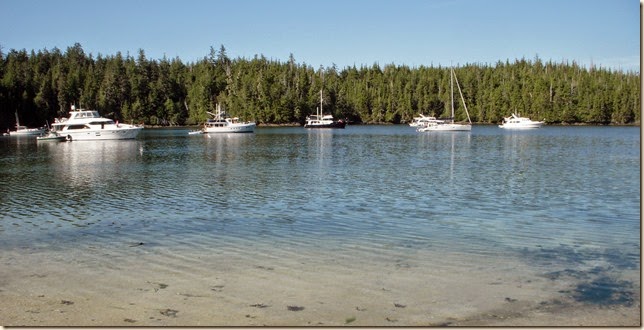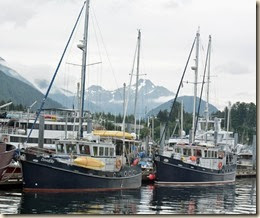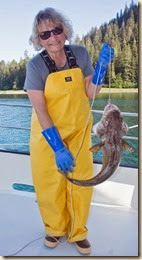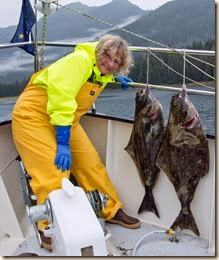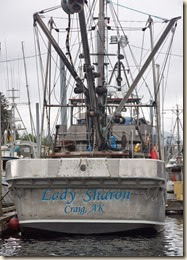From Fredrick Sound we head into Petersburg for a few days to provision. Arriving on Thursday, July 24, our stay was originally to be two days but we stretched it into three when heard the windy forecast in Sumner and Clarence Straits through which we had to travel. A very stable low was sitting in the Gulf of Alaska and it would send periodic waves of rainy and windy weather through SE Alaska, especially the southern portions.
We transited through Wrangell Narrows the afternoon of 7/27 and headed to St John Harbor, directly across Sumner Strait from Wrangell Narrows.
The next morning, after reading the weather report we downloaded via the satphone, we chose to avoid the northern section of Clarence Strait and head down Zimovia Strait and use Ernest Sound to join Clarence Strait only 30 miles north of Ketchikan. Santa Anna Inlet was our anchorage for 7/28.
On the morning of Tuesday, 7/29, we headed for Meyers Chuck, a small Alaskan community at the NW corner of the Cleveland Peninsula, right where Ernest Sound meets Clarence Strait. The forecast we downloaded, updated as of 0648, said Clarence was SE20 knots going to SE15 in the afternoon with 4 foot seas. We were only traveling 2 or 3 miles in Clarence before entering the protected cove of Meyers Chuck.
As we were approaching the area where Ernest Sound met Clarence Strait, the forecasted E10-15 winds of Ernest Sound gave way to first SE20-25 and then SE30+, the seas began to build and our forward speed dropped from 6+ knots (our typical plodding pace) to 3+ knots on account of the head seas were pounding through.
After 45 minutes of nerve wracking pounding followed by and even more nerve wracking 120 degree turn in order to line up with the entrance to Meyers Chuck, we rode the following seas through the narrow entrance. The salon was a bit of a mess as books came crashing out of the book case during rolling we did while executing the turn. We listened to the weather radio and found out that the weather service had issued a 0940 update which changed the Clarence Strait forecast to SE30 knots with 50 knot gusts and 6 foot seas, going to SE20 in the afternoon. We were beaten up in 2011 by Clarence Strait and it did it again.
The next day, the forecast and reality agreed on a pretty nice day, and we arrived in Ketchikan mid-morning on July 30. After our weather experiences of the previous week, we decided get into British Columbia ASAP and we did lots of chores in order to leave the next morning.
July 31 was a beautiful day, we thought the Alaskan weather gods were trying to persuade us to stay a bit longer but we weren’t buying its story. We dropped anchor in Foggy Bay, one of the last good anchorages before crossing Dixon Entrance into Canada.
August 1 we headed into Prince Rupert in order to clear customs and immigration. We stayed at the Prince Rupert Rowing & Yacht Club, probably the most accommodating moorage in the town to transient pleasure craft. It is also convenient to shopping for those forbidden items (most fruits and many vegetables) or customs limited items (beer & wine).
After a lovely night at anchor in Lowe Inlet on August 2, the morning of August 3 we continued down Grenville Channel to do some fishing around Gil Island. After an 1-1/2 hours of trolling, Marcia had one silver and one king salmon and we headed to Cameron Cove for the night.
The next day, August 4, we tried trolling around the south end of Gil Island, a few nibbles but no takers. There was lots of humpback whale activity in the area so that provided some amusement. We also had one near collision with a whale who decided to take a nap (or at least a facsimile of one) on the route to our anchorage. I was pretty close when I noticed this grey mound in the water was neither a wave nor an uncharted rock. I maneuvered around him but he was not alarmed and remained there drifting along. Our Hawk Bay anchorage on Fin Island was only a short distance away.
On August 5, we had the first rain showers since our Clarence Strait experience, a week earlier. That didn’t dissuade Marcia from putting her hooks in the water around Gil Island one more time. After 2 hours we were ready to throw in the towel when a beautiful 27″ silver salmon took the bait. The rainy weather was a blessing because we travelled nearly 60 miles to Bottleneck Inlet with the fish in a cooler filled with cold water before Marcia got her chance to clean the fish when we anchored.
We headed down Finlayson Channel in a thick fog the morning of August 6 but it burned off as we rounded Ivory Island into Seaforth Channel. The wind was picking up so we didn’t fish Idol Point. We tried a new (to us) anchorage in Troup Narrows.
The winds were calm the morning of August 7 as we headed back out to Idol Point. Lots of trolling but no fish was caught. We did see and greet a vessel of another member of our yacht club who was also fishing the area. We hoped to spend the night at the dock in Shearwater but they were fully booked so we dropped the anchor in a satisfactory but not exciting anchorage, Bob Bay.
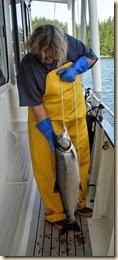 The weather and winds were pretty mellow on August 8 as we cruised Fitz Hugh Sound southbound to fish along Hakai Passage. Our dock neighbors in Eagle Harbor on Bainbridge Island spoke highly of the area. We first tried the north side where 10 or so boats from nearby fishing lodges were fishing. After one pass and no action, we crossed over the the south side. After a half hour or so and right outside the entrance to our anchorage, Marcia hooked and landed a 29″ silver salmon.
The weather and winds were pretty mellow on August 8 as we cruised Fitz Hugh Sound southbound to fish along Hakai Passage. Our dock neighbors in Eagle Harbor on Bainbridge Island spoke highly of the area. We first tried the north side where 10 or so boats from nearby fishing lodges were fishing. After one pass and no action, we crossed over the the south side. After a half hour or so and right outside the entrance to our anchorage, Marcia hooked and landed a 29″ silver salmon.
 The next morning, August 9, we started early for the morning bite. It took a little over an hour of trolling but in nearly the same spot as the night before, Marcia landed a 28″ silver salmon. Since the freezer is getting full, we headed to our anchorage in Pruth Bay. That afternoon we paddled our kayaks to the beach at the head of the bay and walked the trail over to the lovely sandy beach that looks out onto the ocean. For dinner that night Marcia grilled on a cedar plank some of the salmon she had recently caught.
The next morning, August 9, we started early for the morning bite. It took a little over an hour of trolling but in nearly the same spot as the night before, Marcia landed a 28″ silver salmon. Since the freezer is getting full, we headed to our anchorage in Pruth Bay. That afternoon we paddled our kayaks to the beach at the head of the bay and walked the trail over to the lovely sandy beach that looks out onto the ocean. For dinner that night Marcia grilled on a cedar plank some of the salmon she had recently caught.
The sunny weather continued the next day, August 10, as we crossed Fitz Hugh to explore Fish Egg Inlet. We worked our way towards its end and anchored the night in Oyster Bay. It is totally landlocked with trees down to the high tide line, a very different feel from Pruth Bay which, while protected from ocean surf still has an outer coast feel.
With a favorable forecast for the next day, on August 11 we drop the anchor in Fury Cove, a lovely anchorage and conveniently located for rounding Cape Caution. There are already four boats here but before the day ends, another six follow bringing the total to eleven boats (including ourselves).

